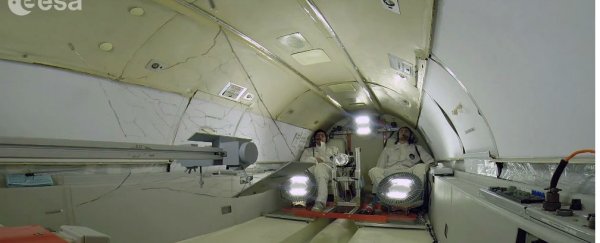To tackle the very modern problem of space junk, scientists at the European Space Agency (ESA) are turning to one of humanity's oldest known tools - the fishing net.
The ESA, which has been developing a mission to capture and remove defunct satellites from low-Earth orbit, recently tested the performance of several weighted fishing nets in microgravity.
During brief periods of weightlessness aboard the Canadian Space Agency's Falcon 20 jet, the ESA researchers fired 20 nets of varying designs out of a compressed air ejector at a model satellite.
The nets were packed inside paper cartons and were "weighted at each corner, helping them to entangle the model satellite," explained ESA engineer Kjetil Wormnes in a press release.
The above video shows the nets in action, fired from close proximity, and effectively enveloping the stationary satellite model.
"The good news is they worked extremely well – so much so that the nets usually had to be cut away with a knife before we could shoot again," said Wormnes.
Nets made from thinner fibres were more effective than those woven from thicker fibres, the team reported.
Decades of launches have left Earth surrounded by a halo of some 17,000 items of debris, larger than tennis balls - and hundreds of thousands more, which are much smaller.
These objects threaten existing space assets and future launches, and the problem is getting so bad, the US Air Force is developing a new Space Fence to bolster monitoring capabilities.
The ESA has plans to begin removing large pieces of debris from low-Earth orbit by 2021, as part of its e.DeOrbit mission.
The nets might be a good option in a simulation, but it's hard to predict how they'd hold against objects spinning wildly out of control.
As Evan Ackerman explains from IEEE Spectrum, tumbling satellites "might run the risk of ripping the net to shreds, breaking the tether, or even dragging the capturing satellite in and causing a new collision."
But Wormnes from the ESA says the nets "can handle a wide range of target shapes and rotation rates."
The challenge is still a formidable one: even if researchers manage to get close enough to rendezvous with defective satellites, and capture them, they still need to figure out how to steer the junk and the salvage craft, in tandem, toward a controlled burn-up during re-entry.
The ESA is studying several capture technologies in tandem, such as robotic arms and harpoons, and has yet to decide on which one will be deployed on the e.DeOrbit mission.
But the agency says "throw-nets have the advantage of scalability – a large enough net can capture anything, no matter its size and attitude."
NASA has investigated using gecko-inspired gripping devices to adhere to pieces of space junk, while several research groups, including a collective of Australian scientists, envision using lasers to do the clean-up job.
As the problem is only getting worse, mitigation efforts will probably need to include a range of these options. If that means fishing nets in space, we say go for it!
Source: IEEE Spectrum
